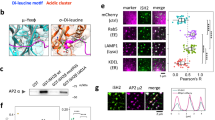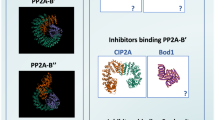Abstract
The tumour suppressor PTEN can inhibit cell proliferation and migration as well as control cell growth, in different cell types1. PTEN functions predominately as a lipid phosphatase, converting PtdIns(3,4,5)P3 to PtdIns(4,5)P2, thereby antagonizing PI(3)K (phosphoinositide 3-kinase) and its established downstream effector pathways2. However, much is unclear concerning the mechanisms that regulate PTEN movement to the cell membrane, which is necessary for its activity towards PtdIns(3,4,5)P3 (Refs 3, 4, 5). Here we show a requirement for functional motor proteins in the control of PI3K signalling, involving a previously unknown association between PTEN and myosinV. FRET (Förster resonance energy transfer) measurements revealed that PTEN interacts directly with myosinV, which is dependent on PTEN phosphorylation mediated by CK2 and/or GSK3. Inactivation of myosinV-transport function in neurons increased cell size, which, in line with known attributes of PTEN-loss6,7, required PI(3)K and mTor. Our data demonstrate a myosin-based transport mechanism that regulates PTEN function, providing new insights into the signalling networks regulating cell growth.
This is a preview of subscription content, access via your institution
Access options
Subscribe to this journal
Receive 12 print issues and online access
$209.00 per year
only $17.42 per issue
Buy this article
- Purchase on Springer Link
- Instant access to full article PDF
Prices may be subject to local taxes which are calculated during checkout




Similar content being viewed by others
Change history
05 October 2009
In the version of this article initially published, the directions of the horizontal arrows in Fig. 4b were reversed. This error has been corrected in the HTML and PDF versions of the article.
References
Salmena, L., Carracedo, A. & Pandolfi, P. P. Tenets of PTEN tumor suppression. Cell 133, 403–414 (2008).
Sulis, M. L. & Parsons, R. PTEN: from pathology to biology. Trends Cell Biol. 13, 478–483 (2003).
Pinal, N. et al. Regulated and polarized PtdIns(3, 4, 5)P3 accumulation is essential for apical membrane morphogenesis in photoreceptor epithelial cells. Curr. Biol. 16, 140–149 (2006).
Takahashi, Y., Morales, F. C., Kreimann, E. L. & Georgescu, M. M. PTEN tumor suppressor associates with NHERF proteins to attenuate PDGF receptor signaling. EMBO J. 25, 910–920 (2006).
Vazquez, F. et al. Tumor suppressor PTEN acts through dynamic interaction with the plasma membrane. Proc. Natl Acad. Sci. USA 103, 3633–3638 (2006).
Kwon, C. H., Zhu, X., Zhang, J. & Baker, S. J. mTor is required for hypertrophy of Pten-deficient neuronal soma in vivo. Proc. Natl Acad. Sci. USA 100, 12923–12928 (2003).
Kwon, C. H. et al. Pten regulates neuronal arborization and social interaction in mice. Neuron 50, 377–388 (2006).
Chadborn, N. H. et al. PTEN couples Sema3A signalling to growth cone collapse. J. Cell Sci. 119, 951–957 (2006).
Heit, B. et al. PTEN functions to 'prioritize' chemotactic cues and prevent 'distraction' in migrating neutrophils. Nature Immunol. 9, 743–752 (2008).
Iijima, M. & Devreotes, P. Tumor suppressor PTEN mediates sensing of chemoattractant gradients. Cell 109, 599–610 (2002).
Martin-Belmonte, F. et al. PTEN-mediated apical segregation of phosphoinositides controls epithelial morphogenesis through Cdc42. Cell 128, 383–397 (2007).
Krendel, M. & Mooseker, M. S. Myosins: tails (and heads) of functional diversity. Physiology (Bethesda) 20, 239–251 (2005).
Torres, J. & Pulido, R. The tumor suppressor PTEN is phosphorylated by the protein kinase CK2 at its C terminus. Implications for PTEN stability to proteasome-mediated degradation. J. Biol. Chem. 276, 993–998 (2001).
Al-Khouri, A. M., Ma, Y., Togo, S. H., Williams, S. & Mustelin, T. Cooperative phosphorylation of the tumor suppressor phosphatase and tensin homologue (PTEN) by casein kinases and glycogen synthase kinase 3β. J. Biol. Chem. 280, 35195–35202 (2005).
Sumitomo, M. et al. Synergy in tumor suppression by direct interaction of neutral endopeptidase with PTEN. Cancer Cell 5, 67–78 (2004).
Parsons, M., Messent, A. J., Humphries, J. D., Deakin, N. O. & Humphries, M. J. Quantification of integrin receptor agonism by fluorescence lifetime imaging. J. Cell Sci. 121, 265–271 (2008).
Mercer, J. A., Seperack, P. K., Strobel, M. C., Copeland, N. G. & Jenkins, N. A. Novel myosin heavy chain encoded by murine dilute coat colour locus. Nature 349, 709–713 (1991).
Wang, F. S., Wolenski, J. S., Cheney, R. E., Mooseker, M. S. & Jay, D. G. Function of myosin-V in filopodial extension of neuronal growth cones. Science 273, 660–663 (1996).
Espreafico, E. M. et al. Primary structure and cellular localization of chicken brain myosin-V (p190), an unconventional myosin with calmodulin light chains. J. Cell Biol. 119, 1541–1557 (1992).
Sanal, O. et al. An allelic variant of Griscelli disease: presentation with severe hypotonia, mental-motor retardation, and hypopigmentation consistent with Elejalde syndrome (neuroectodermal melanolysosomal disorder). J. Neurol. 247, 570–572 (2000).
Kwon, C. H. et al. Pten regulates neuronal soma size: a mouse model of Lhermitte-Duclos disease. Nature Genet 29, 404–411 (2001).
van Diepen, M. T. & Eickholt, B. J. Function of PTEN during the formation and maintenance of neuronal circuits in the brain. Dev. Neurosci. 30, 59–64 (2008).
Zhao, L. P. et al. Cloning and characterization of myr 6, an unconventional myosin of the dilute/myosin-V family. Proc. Natl Acad. Sci. USA 93, 10826–10831 (1996).
Rodriguez, O. C. & Cheney, R. E. Human myosin-Vc is a novel class V myosin expressed in epithelial cells. J. Cell Sci. 115, 991–1004 (2002).
Brown, J. R., Peacock-Villada, E. M. & Langford, G. M. Globular tail fragment of myosin-V displaces vesicle-associated motor and blocks vesicle transport in squid nerve cell extracts. Biol. Bull. 203, 210–211 (2002).
Saito, T. & Nakatsuji, N. Efficient gene transfer into the embryonic mouse brain using in vivo electroporation. Dev. Biol. 240, 237–246 (2001).
Rahdar, M. et al. A phosphorylation-dependent intramolecular interaction regulates the membrane association and activity of the tumor suppressor PTEN. Proc. Natl Acad. Sci. USA 106, 480–485 (2009).
Vazquez, F., Ramaswamy, S., Nakamura, N. & Sellers, W. R. Phosphorylation of the PTEN tail regulates protein stability and function. Mol. Cell. Biol. 20, 5010–5018 (2000).
Spittaels, K. et al. Neonatal neuronal overexpression of glycogen synthase kinase-3 β reduces brain size in transgenic mice. Neuroscience 113, 797–808 (2002).
Acknowledgements
This work was funded by the Biotechnology and Biological Science Research Council to B.J.E. (BB/C514307/1), an MRC program grant to C.P.D. (G9403619). M.P. is a Royal Society University Research Fellow. We thank J. Hammer III for providing the myosinVa cDNA, C. Sutherland for the GSK3 inhibitor CT99021, E. Blanc for help with statistical analyses and F. Gertler for comments on the manuscript.
Author information
Authors and Affiliations
Contributions
All authors designed experiments; M.v.D., M.P., R.H. and B.J.E. performed research and B.J.E. wrote the manuscript.
Corresponding author
Ethics declarations
Competing interests
The authors declare no competing financial interests.
Supplementary information
Supplementary Information
Supplementary Information (PDF 1473 kb)
Rights and permissions
About this article
Cite this article
van Diepen, M., Parsons, M., Downes, C. et al. MyosinV controls PTEN function and neuronal cell size. Nat Cell Biol 11, 1191–1196 (2009). https://doi.org/10.1038/ncb1961
Received:
Accepted:
Published:
Issue Date:
DOI: https://doi.org/10.1038/ncb1961
This article is cited by
-
The murine ortholog of Kaufman oculocerebrofacial syndrome protein Ube3b regulates synapse number by ubiquitinating Ppp3cc
Molecular Psychiatry (2021)
-
The functions and regulation of the PTEN tumour suppressor: new modes and prospects
Nature Reviews Molecular Cell Biology (2018)
-
Regulation and modulation of PTEN activity
Molecular Biology Reports (2018)
-
The molecular motor Myosin Va interacts with the cilia-centrosomal protein RPGRIP1L
Scientific Reports (2017)
-
PRL-3 Promotes the Malignant Progression of Melanoma via Triggering Dephosphorylation and Cytoplasmic Localization of NHERF1
Journal of Investigative Dermatology (2015)



